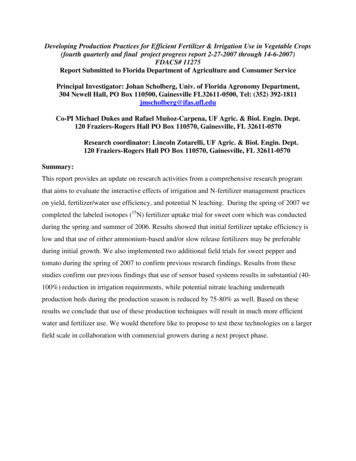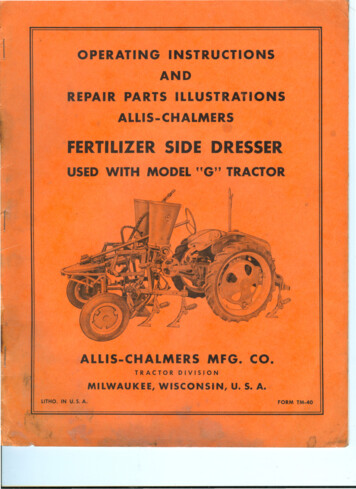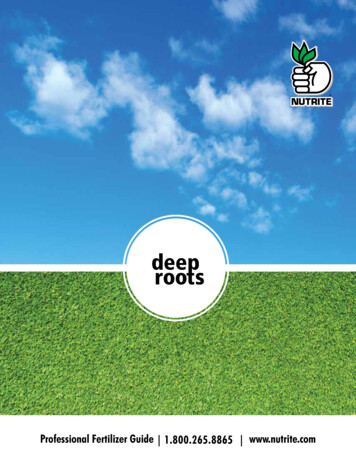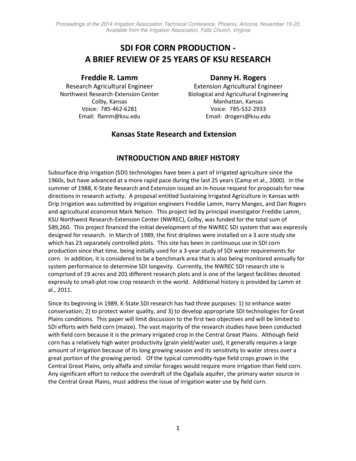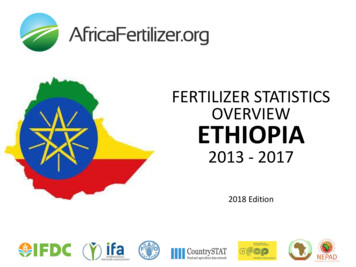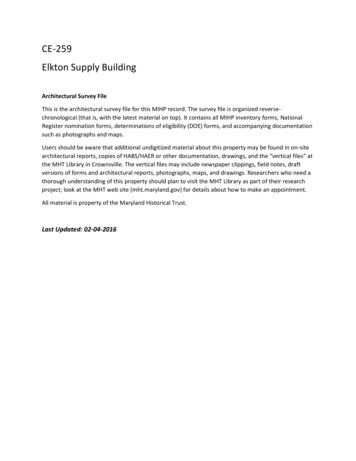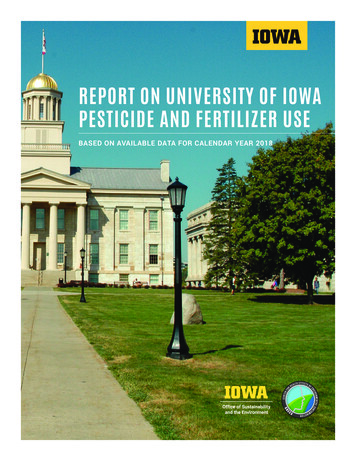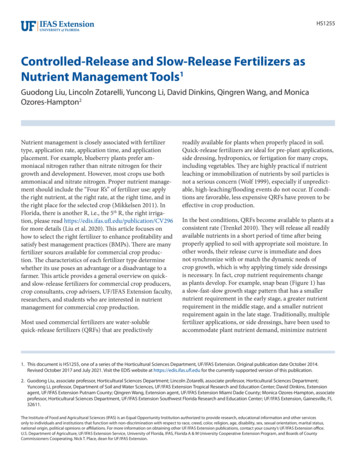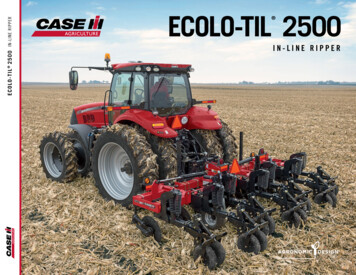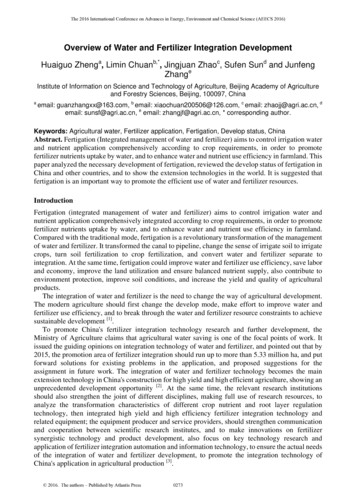
Transcription
The 2016 International Conference on Advances in Energy, Environment and Chemical Science (AEECS 2016)Overview of Water and Fertilizer Integration DevelopmentHuaiguo Zhenga, Limin Chuanb,*, Jingjuan Zhaoc, Sufen Sund and JunfengZhangeInstitute of Information on Science and Technology of Agriculture, Beijing Academy of Agricultureand Forestry Sciences, Beijing, 100097, Chinaaemail: guanzhangxx@163.com, b email: xiaochuan200506@126.com, c email: zhaojj@agri.ac.cn, demail: sunsf@agri.ac.cn, e email: zhangjf@agri.ac.cn, * corresponding author.Keywords: Agricultural water, Fertilizer application, Fertigation, Develop status, ChinaAbstract. Fertigation (Integrated management of water and fertilizer) aims to control irrigation waterand nutrient application comprehensively according to crop requirements, in order to promotefertilizer nutrients uptake by water, and to enhance water and nutrient use efficiency in farmland. Thispaper analyzed the necessary development of fertigation, reviewed the develop status of fertigation inChina and other countries, and to show the extension technologies in the world. It is suggested thatfertigation is an important way to promote the efficient use of water and fertilizer resources.IntroductionFertigation (integrated management of water and fertilizer) aims to control irrigation water andnutrient application comprehensively integrated according to crop requirements, in order to promotefertilizer nutrients uptake by water, and to enhance water and nutrient use efficiency in farmland.Compared with the traditional mode, fertigation is a revolutionary transformation of the managementof water and fertilizer. It transformed the canal to pipeline, change the sense of irrigate soil to irrigatecrops, turn soil fertilization to crop fertilization, and convert water and fertilizer separate tointegration. At the same time, fertigation could improve water and fertilizer use efficiency, save laborand economy, improve the land utilization and ensure balanced nutrient supply, also contribute toenvironment protection, improve soil conditions, and increase the yield and quality of agriculturalproducts.The integration of water and fertilizer is the need to change the way of agricultural development.The modern agriculture should first change the develop mode, make effort to improve water andfertilizer use efficiency, and to break through the water and fertilizer resource constraints to achievesustainable development [1].To promote China's fertilizer integration technology research and further development, theMinistry of Agriculture claims that agricultural water saving is one of the focal points of work. Itissued the guiding opinions on integration technology of water and fertilizer, and pointed out that by2015, the promotion area of fertilizer integration should run up to more than 5.33 million ha, and putforward solutions for existing problems in the application, and proposed suggestions for theassignment in future work. The integration of water and fertilizer technology becomes the mainextension technology in China's construction for high yield and high efficient agriculture, showing anunprecedented development opportunity [2]. At the same time, the relevant research institutionsshould also strengthen the joint of different disciplines, making full use of research resources, toanalyze the transformation characteristics of different crop nutrient and root layer regulationtechnology, then integrated high yield and high efficiency fertilizer integration technology andrelated equipment; the equipment producer and service providers, should strengthen communicationand cooperation between scientific research institutes, and to make innovations on fertilizersynergistic technology and product development, also focus on key technology research andapplication of fertilizer integration automation and information technology, to ensure the actual needsof the integration of water and fertilizer development, to promote the integration technology ofChina's application in agricultural production [3]. 2016. The authors – Published by Atlantis Press0273
The 2016 International Conference on Advances in Energy, Environment and Chemical Science (AEECS 2016)Fertigation Development in Foreign CountriesBritain. The integration of water and fertilizer originated in soilless culture, and with thedevelopment of efficient irrigation technology to develop. At the end of eighteenth Century, JohnWoodward, who was from Britain, made the plant grown in soil extract water, which is the firstintegration of water and fertilizer cultivation. The first test of trickle irrigation technology in theworld can be traced back to the 19th century, but really originated from the early 1950s and 1960s. Inthe 1970s, due to mass production of cheap plastic pipe, it greatly promoted the trickle irrigation andmicro irrigation systems development, including drip irrigation, micro spray irrigation and microsprinkler irrigation, and in the past 40 years, fertilizer integration technology in the world has a rapiddevelopment [1].United States. In 1913, the United States built the first drip irrigation project, which is the largestcountry of micro irrigation area currently in the world. There were 60% of potatoes, 25% corn, 33%of the fruit trees in irrigated agriculture are used fertilizer integration technology. The new type ofwater soluble fertilizer and pesticide injection control device were development and applied inagriculture, and the special fertilizer used for fertigation was accounted for 38% of the total amount.The United States has arranged a variety of water-saving irrigation systems. For example, Californiahas established a perfect integration of water and fertilizer facilities and service system, of which50% of the total area adopting sprinkler, 43% for surface irrigation, 6% for drip irrigation, and 1% forother instruments. Fixed sprinkler irrigation and mobile sprinkler irrigation, of which 80% for axialmovable sprinkler irrigation. Drip irrigation area is increasing year by year, and the most effectiveirrigation method is under plastic film drip.Germany. Germany made the water flow to soil from a hole, which was a breakthrough in 1920.After the rise of the plastics industry in the 1950s, more efficient irrigation technology has been rapiddevelopment, and irrigation and fertilization soon be combined, and formed a new agriculturaltechnology with high precision control of soil moisture and nutrient.Netherlands. Since the early 1950s in Netherlands, the number of greenhouse slowly increased, andthe liquid fertilizer used for irrigation system also has increased significantly. With that, the pump forprecise nutrient supply of fertilizer and mixing tank has been developed.Australia. In recent years, fertilizer integration technology in Australia developed rapidly. Australiaallocated a total of 100 billion for national water safety plan in 2006 and 2007, for development ofirrigation facilities and fertilizer integration technology, and the establishment of soil moisturemonitoring system used to guide irrigation and fertilization.Israel. Israel has experienced several periods of agricultural irrigation, i.e., flood irrigation, furrowirrigation, sprinkler irrigation, drip irrigation and other development stages. Since the beginning ofthe sixties of the 20th century, irrigation and fertilization technology became popular. The nationalwater supply system for irrigation and fertilizer application was built in 1964. More than half of thearable land in the country is applied to the irrigation and fertilization system, including fruit trees,flowers, greenhouse crops, field vegetables and field crops. At the beginning of the eighties of the20th century, the irrigation and fertilization technology in Israeli turned to automatic propellingmachine irrigation system, and fertilization system combined the fertilizer tank, a venturi vacuumpump and hydraulic driven fertilizer syringe together, and introduced computer control technologyand equipment, make the nutrient distribution more uniformity. Israelis actively develop and promotewater-saving technologies and equipment, in order to use a small amount of water to meet the needsof the crops in sandy land, and put forward the idea of "watering crops instead of watering the soil".At present, Israel each year introduced and extended new technologies and equipment for dripirrigation, and from the drip irrigation technology derived buried irrigation, sprinkler irrigation,distributed irrigation etc., some of these technologies have been adopted by China and otherinternational market [4].India. India has introduced the micro irrigation technology since 1981, and began to develop a largerscale after 1986. Now micro irrigation area in India has reached 26 million hectares. The governmentof India developed micro irrigation development grant program in 1992-1997, and state subsidies of 2016. The authors – Published by Atlantis Press0274
The 2016 International Conference on Advances in Energy, Environment and Chemical Science (AEECS 2016)horticultural crops irrigation system with a total investment of 90%, about 4950 yuan per hectare. Inthe "eight five" period, the government of India invest 280 million to irrigation project. In order toprotect and promote the orchard development, some states implemented the orchard irrigationassistance plan, and thus to promote the rapid development of micro irrigation technology. At present,India has more than 70 different sizes of micro irrigation equipment manufacturers, which the fivelargest equipment manufacturers accounted for 78% of total market sales. India also exportsirrigation equipment to Sri Lanka and the Middle East, and the annual total exports accounted for10%-15% of total output [5]. In India, many public agricultural university and National AgriculturalResearch Institute have done much research on micro irrigation technology and development, andheld many short term training courses for agricultural water conservancy officials and farmers. Alsothe government used a variety of media play to promote drip irrigation technology extension.In addition, Italy, Spain, France, Japan, South Africa and other countries also has the rapiddevelopment of fertilizer integration technology. According to the Sixth International microassembly information, the micro irrigation area increased 633% from 1981 to 2000, with an averageannual increased by 33%, and up to 373.33 million hm2, most of which used fertilizer integrationtechnology. Entering the new century, fertilizer integration technology development more rapidlyand further expand the application area. In addition, the various water soluble fertilizer developmentand production has made great progress, which matched with the water and fertilizer integration.Another is, some developed countries have formed a perfect equipment production, the allocation offertilizer and promotion service system.Fertigation Development in ChinaChina started research on integration technology of water and fertilizer from 1975. At that time,China introduced the drip irrigation equipment from Mexico, and established 3 experimental siteswith an area of 5.3 hm2, and has achieved significant increase effect on production and water saving.In 1977, Xinjiang Academy of Agricultural Science reclamation scientific learning experience fromIsrael, and purchased drip irrigation equipment to carry out the drip irrigation experiment forvegetables, fruits and other horticultural crops. The results showed that drip irrigation technology hadan important effect on water-saving and yield increasing, also helped to save labor and economy. Thefirst generation of drip irrigation equipment was successful development and produced in our countryin 1980. After 1981, based on the introduction of foreign advanced production technology, the scaleproduction of irrigation equipment in China has gradually formed, and gradually developed into alarge area form the experiment and demonstration.From the middle of 1990s, the theory and application technology of the irrigation fertilization havebeen paid more and more attention. The Ministry of Agriculture started the organization andimplementation of water-saving agricultural project in 2002, established demonstration area offertilizer integration technology. China formulated work plans for water-saving, i.e. the nationalagricultural water-saving program (2012-2020), the development principles concerning promotingthe farmland water-saving work opinions, the national farmland water-saving demonstration program,and the guiding opinions on fertilizer integration technology. The government adheres to the developprinciples of the amount of water limited, ecological priority, quality and efficiency improved,farmers' income increase, also integrated various funds and increase investment, effectivelypromoted the popularization of fertilizer integration technology, and achieved remarkable results.The application scale continues to expand. Since 2002, the Ministry of Agriculture implementednational dryland farming and water saving projects, and invested a total of more than 1 billion yuan,to set up fertilizer integration technology of core demonstration area of 3.33 million hm2 in more than20 provinces, focused on experimental demonstration and technical integration, which covering morethan 20 kinds of crops, effectively promoted the popularization and application of the integrationtechnique of water and fertilizer. At present, the technology has been expanded in nearly 30 provinces,and the fertigation has applied by extended to wheat, corn, potato, soybean and other crops, and theexpanded application area was 266.7 million hm2 each year [6]. 2016. The authors – Published by Atlantis Press0275
The 2016 International Conference on Advances in Energy, Environment and Chemical Science (AEECS 2016)Continuous innovation of technology model. According to the principle of suiting measures tolocal conditions, following the crop water requirement rules and water resource conditions andcharacteristics of the equipment, the government carried out technology integration, and formed aseries of fertilizer integration technology mode. Divided according to the region, there were arid andsemi arid region of membrane drip irrigation, hilly gravity drip irrigation and fertigation, plain microspray water and fertilizer integration mode; divided by the equipment, there were mobile microirrigation and fertilization integration mode, full automatic intelligent integration patterns of waterand fertilizer, small simple self-service fertilizer integration mode. According to the condition offacilities, there were general field fertilizer integration mode, greenhouse film surface set rain waterand fertilizer integration mode and so on.Continuous improvement of technical products. With the popularization and application offertilizer integration technology, constantly reinforce the foundation work, and constantly improvethe technology related products. The soil moisture monitoring method and equipment were alsodeveloped, and it can quickly obtained the soil moisture status, in order to laid the foundation for soilmoisture precise management; through a series of experiments carried out in different regions anddifferent crops, it could observed a large number of micro irrigation conditions irrigation andfertilization technology parameters, and make pattern optimization, compile technical data, for waterand fertilizer to promote the integration of technology application provides scientific basis; a varietyof spray and drip irrigation pipe (belt), filtering and fertilizing equipment product is becoming moreand more mature, expand the scope of application, continuously improve the durability, stronglysupport the integrated development of water and fertilizer. Water soluble fertilizer research anddevelopment aspects breakthrough, for micro irrigation water soluble fertilizer varieties areconstantly emerging, provide supporting agricultural fertilizer integration technology popularizationand application.To optimize the promotion mechanism. In the experimental demonstration and extension work formany years, the integration of water and fertilizer technology promotion mechanism has beenexplored. Governments promote the model by their investment and technical subsidies, in order topromote the fertigation application. Technology driven mode, through the technical promotiondepartment to carry out the demonstration and training of technical to promote the application.Enterprise pulling mode, through relevant enterprises to carry out equipment products distributionactivities, for farmers to provide products and services, technology combined pull applied;professional cooperative organizations of farmers driving mode. To all types of specialized farmercooperatives as the carrier, promote organized and standardized production and technologypopularization and application [7].Input costs significantly reduced. Through the focus on research related equipment, optimizing theintegration of water and fertilizer system design and development of micro irrigation water solublefertilizer, the basic realization of the localization of fertilizer integration related facilities, equipmentand products, dramatically reducing the cost of inputs. Input equipment and facilities have been from2000 to 3000 yuan / 667m2 significantly reduced to 800 yuan / 667m2, efficient water solublefertilizer reduced from 20000 yuan per ton to 1 million yuan per ton, fertigation began from high-endaristocrat technologies to civilian applications development, from agricultural facilities to fieldapplication, from vegetables, fruit trees, cotton, and other economic crops development to wheat,corn, potato and other crops.SummaryIt is suggested that fertigation is the important way to promote the efficient use of water and fertilizerresources. China should pay more attention to develop the fertigation technology, in order to makefull use of the water and fertilizers. 2016. The authors – Published by Atlantis Press0276
The 2016 International Conference on Advances in Energy, Environment and Chemical Science (AEECS 2016)AcknowledgementsFunding for this research is provided by the Innovation Program of Beijing Academy of Agriculturaland Forestry Sciences “Information research to promote the agricultural science and technologyinnovation ability” and “Structure evolution and driving forces analysis of agricultural water use inBeijing”.References[1] X.Z. Gao, S. Du, Y.H. Zhong, Y. Wu, and G. Zhang. Present situation and Prospect of theintegrated development of water and fertilizer. China Agricultural Information, Vol. 02 (2015), p.14-19, 63.[2] Information on http://www.moa.gov.cn/zwllm/zwdt/201303/t20130304 3236967.htm[3] G.F. Chen, S. Du, R.F. Jiang, X.Z. Gao. The present situation of research and application of waterand fertilizer integration technology in our country. China Agricultural Technology Extension,Vol. 05 (2013), p. 39-41.[4] Y. M. Li, J. Ren, H.T. Liu, L.C. Wang. Introduction and Enlightenment of Fertigation in Israel.Journal of Jilin Agricultural Sciences, Vol. 39(2014), p:91-93.[5] L.L. Yang, H.W. Zhang, M.Q. Han, C.Z. Wang and S.M. Yang. Analysis of Techniques andApplication Prospect of Water and Fertilizer Integration Technology. Journal of Anhui Agri. Sci.,Vol. 43(2015), p: 13-25, 28.[6] P. Gao, H.Z. Jian, Y. Wei, W. He, X.F. Wang. The Application Status and Development Prospectof Integrative Water and Fertilizer. Modern agricultural science and technology, Vol. 8 (2012), p:250, 257.[7] J. Zhao. The problems and solutions in the adaption of fertigation technology. Northwest A&FUniversity, 2015. 2016. The authors – Published by Atlantis Press0277
movable sprinkler irrigation. Drip irrigation area is increasing year by year, and the most effective irrigation method is under plastic film drip. Germany. Germany made the water flow to soil from a hole, which was a breakthrough in 1920. After the rise of the plastics industry in the 1950s, more efficient irrigation technology has been rapid
